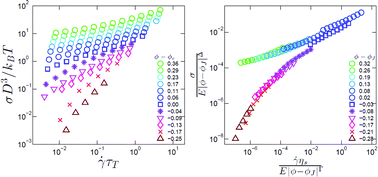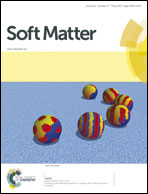Rheology of soft colloids across the onset of rigidity: scaling behavior, thermal, and non-thermal responses†
Abstract
We study the rheological behavior of colloidal suspensions composed of soft sub-micron-size hydrogel particles across the liquid–solid transition. The measured stress and strain-rate data, when normalized by thermal stress and time scales, suggest our systems reside in a regime wherein thermal effects are important. In a different vein, critical point scaling predictions for the jamming transition, typical in athermal systems, are tested. Near dynamic arrest, the suspensions exhibit scaling exponents similar to those reported in Nordstrom et al., Phys. Rev. Lett., 2010, 105, 175701. The observation suggests that our system exhibits a glass transition near the onset of rigidity, but it also exhibits a jamming-like scaling further from the transition point. These observations are thought-provoking in light of recent theoretical and simulation findings, which show that suspension rheology across the full range of microgel particle experiments can exhibit both thermal and athermal mechanisms.


 Please wait while we load your content...
Please wait while we load your content...